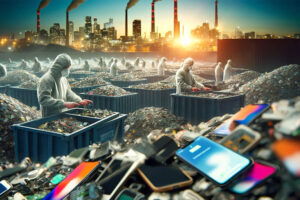 Digitisation is driving great change in the energy sector, impacting business models and driving innovation. It has created a digital backbone that not only supports the transition from fossil fuels to renewables, but also creates the ability to connect the energy system to our personal and local ecosystems. This digital, or smart, network is the foundation for what is potentially the biggest shift the energy sector will see – a move from the system of ‘old’, with its push, supply driven, utility scale, macro approach, to a micro customer-centered system where everything at the demand end of the energy chain plays a part in the network in a way that it has never been able to do before.
Digitisation is driving great change in the energy sector, impacting business models and driving innovation. It has created a digital backbone that not only supports the transition from fossil fuels to renewables, but also creates the ability to connect the energy system to our personal and local ecosystems. This digital, or smart, network is the foundation for what is potentially the biggest shift the energy sector will see – a move from the system of ‘old’, with its push, supply driven, utility scale, macro approach, to a micro customer-centered system where everything at the demand end of the energy chain plays a part in the network in a way that it has never been able to do before.
Technology is the key enabler of this demand-driven approach. From solar panels to air conditioners, electric vehicles to pool pumps, in recent years there has been a proliferation of smart devices, connected to the Internet of Things, which can potentially be used in the wider energy system. At a small scale they can help individuals better manage their energy use and ultimately, take control of their power. But on a larger scale they have the potential to revolutionise the energy sector.
Currently in response to signals from the market, households and businesses can optimise their resources on an individual basis. But in isolation, these small transactions have minimal impact on the wider energy system. However, digitisation creates the ability to join forces and connect hundreds, if not thousands of households, which would see each individual, incremental activity achieve an aggregated impact, potentially the equivalent of turning on and off a large gas fired generator, or very large battery. By orchestrating these resources continuously to manage supply and demand, it becomes possible to achieve the holy grail of price reduction, greater efficiency and better outcomes for the environment. The utopian future is this seamless operation working harmoniously together, an optimised system right down to the household level. While the technology exists to achieve this nirvana, to date no one has been able to build the structure to deliver it and orchestrate those resources on a broad scale. There is currently a gap between present day and the utopian possibilities and if we are to ensure transformation, as opposed to obsolescence, the sector must first address several areas: skills, regulatory and consumer trust challenges.
Aurecon’s The Digital Horizon report looks at micro-scenarios that offer a glimpse into the future of energy, transport, property and the workforce, and the role technology will play as a key driver of change. We consider some of these future drivers below.
The energy workforce of the future
A combination of skills is needed to deliver the possibilities for the energy future. First principles in engineering remain essential, but these are needed in addition to other, very different digital skills. Aurecon looks at smart energy practitioners and electrical engineers with an ability to code and script, alongside app developers and data analysists who also understand energy. These skills may not reside in the same person, but they should do so in the same organisation. Identifying which areas an organisation needs skills in, and upskilling the workforce to achieve this, is fundamental to solving wicked problems of the future.
Mindset is also paramount in creating the workforce of the future. The energy sector needs unconventional thinkers who believe disruption is a positive, that it will break down old barriers and take us where we want to go. These people are change agents, have open minds and genuinely want to unlock a better future for everyone – which will be integral in building trust right down to the consumer end.
Building trust in the system
Trust is currently a major barrier for the micro, demand-driven energy system of the future. Digital platforms are built to enable joining millions of individual users, and tech such as automation, artificial intelligence and machine learning can automatically ‘take control’ of our devices (such as dialing back pool pumps or air conditioners) to balance supply and demand. As this occurs, consumers need confidence the ‘lack of control’ won’t affect their lifestyle. People have to trust the system, trust the skills of the people creating the system, and also believe that handing over control digitally is going to be better for them and the wider community.
Other industries have successfully broken the trust barrier – telecoms with Wi-Fi and banking’s move from bricks and mortar to online transactions. For both, data and digital tech was the bridge that ultimately built trust. Similarly in energy, an interface for consumers that provides visibility, control, builds confidence and ensures privacy will be a game changer for building trust and making this demand-driven energy system of the future a widespread reality. Not dissimilar to Uber, a simple, clear interface where individuals stipulate which devices to never touch, those that can be dialed up and down, select pricing in specific ranges, total energy costs and so on. For energy, the breakthrough may be thanks to voice assistants (e.g. Alexa or Siri) – as it becomes more widely accepted that they can provide accurate information and orchestrate devices around the household, the energy sector can tap into this trusted interface to become the single point to communicate with the outside energy world.
Tech and tools to transform
As the energy industry continues to rapidly evolve, in partnership with skills and gaining trust, it is essential to continue development of digital platforms, tech and tools that will allow the industry to revolutionize. Aurecon worked on South Australia’s Virtual Power Plant (VPP), which is a first step toward the utopian future where all devices can be controlled as part of the wider energy system.
The VPP takes a simple part of the infrastructure and incentivizes households to install solar panels and batteries and then allow those assets to be centrally controlled and played in the wholesale market as if they were a singular asset, or one power station. Those households have cheaper energy bills and they are contributing to a wider energy ecosystem which is more efficient, less wasteful and better for the environment. Other state governments are doing similar projects and several universities too are pioneering in this space with micro-grids, at a campus scale, playing all assets together and optimizing use within the campus, on both the generation and demand side.
Regulation a double-edged sword
There are also a handful of pioneers trying to create change in the energy sector, such as retailers using blockchain energy for households with solar and batteries, or Pooled Energy that is focusing on the pool pump market which are huge energy users and flexible in terms of when they can be turned on and off. However, these pioneers are operating in a heavily regulated market, which is a double-edged sword. This regulation has created a good system and delivered reliable supply for a very long time. The downside to that regulation is it is very slow to change. Although the utopian future is technically achievable, unless we modify the rules to allow change, it will be challenging to realize the possibilities.
We are currently seeing this with the proliferation of solar panels. Coal fired generation is decreasing (with 45TWh set to retire by 2030), and consumers have responded with a change in energy supply featuring a huge increase in solar, particularly rooftop PV. This presents an opportunity for peer to peer trading, but currently those with excess solar have no way to do that transaction. New start-ups are trying to find a way within the current rules to enable this, however peer to peer trading is hard to monetize, there are more hurdles than disruptors such as Uber faced, and with conservative regulators it is very had to drive change.
But looking long-term, change is inevitable and if the industry doesn’t give customers this kind of future, it’s possible they will pursue another path, be that disconnection and self-generation, or any other avenue that allows them to get away from the existing model.
A customer-centered energy system is what we need for the future. It is the ultimate prize of price reduction through greater efficiency, continued reliability and better environmental outcomes. It is also more dynamic – a crucial factor as we build more intermittent renewables in the wholesale system at a utility scale. There are great challenges in the journey to the energy nirvana, however we have the technology that underpins this future, we can do more with what we already have, we can give customers comfort around price and give them more control. We just need the right skills, tech, tools and rules.















